Business Strategy Report: Tesco's Macro and Micro Environment
VerifiedAdded on 2023/01/13
|13
|4546
|23
Report
AI Summary
This report provides a comprehensive analysis of Tesco's business strategy, examining both the external macro environment and internal capabilities. It utilizes the PESTLE framework to assess political, economic, social, technological, environmental, and legal factors impacting Tesco's operations. The report also includes a VRIO analysis to evaluate Tesco's resources and capabilities, a SWOT analysis to identify strengths, weaknesses, opportunities, and threats, and Porter's Five Forces to analyze the competitive landscape of the retail industry. The findings from these analyses are then used to devise a strategic management plan aimed at enhancing Tesco's efficiency, effectiveness, and overall market position. The report concludes by summarizing key insights and recommendations for Tesco's strategic decision-making.
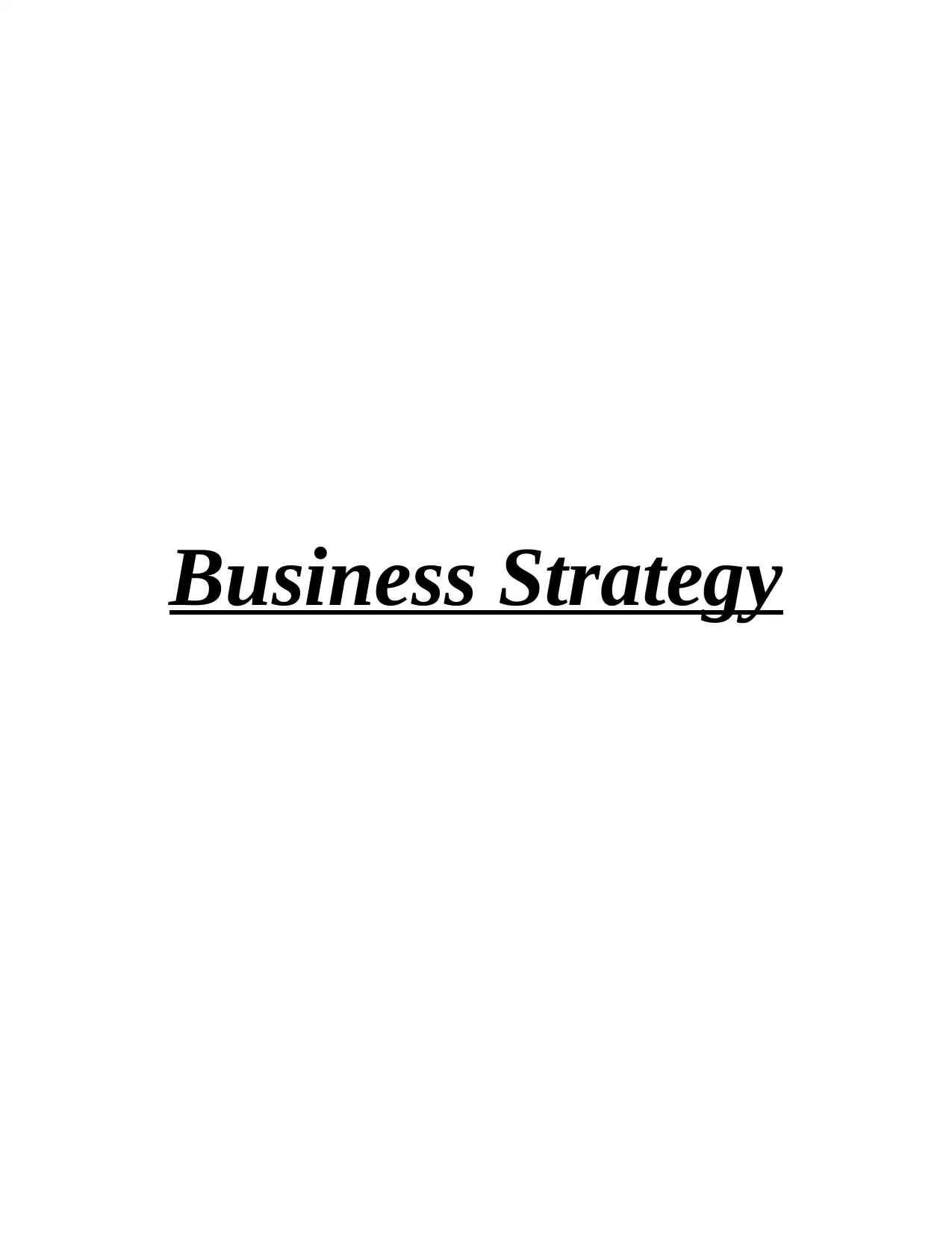
Business Strategy
Paraphrase This Document
Need a fresh take? Get an instant paraphrase of this document with our AI Paraphraser
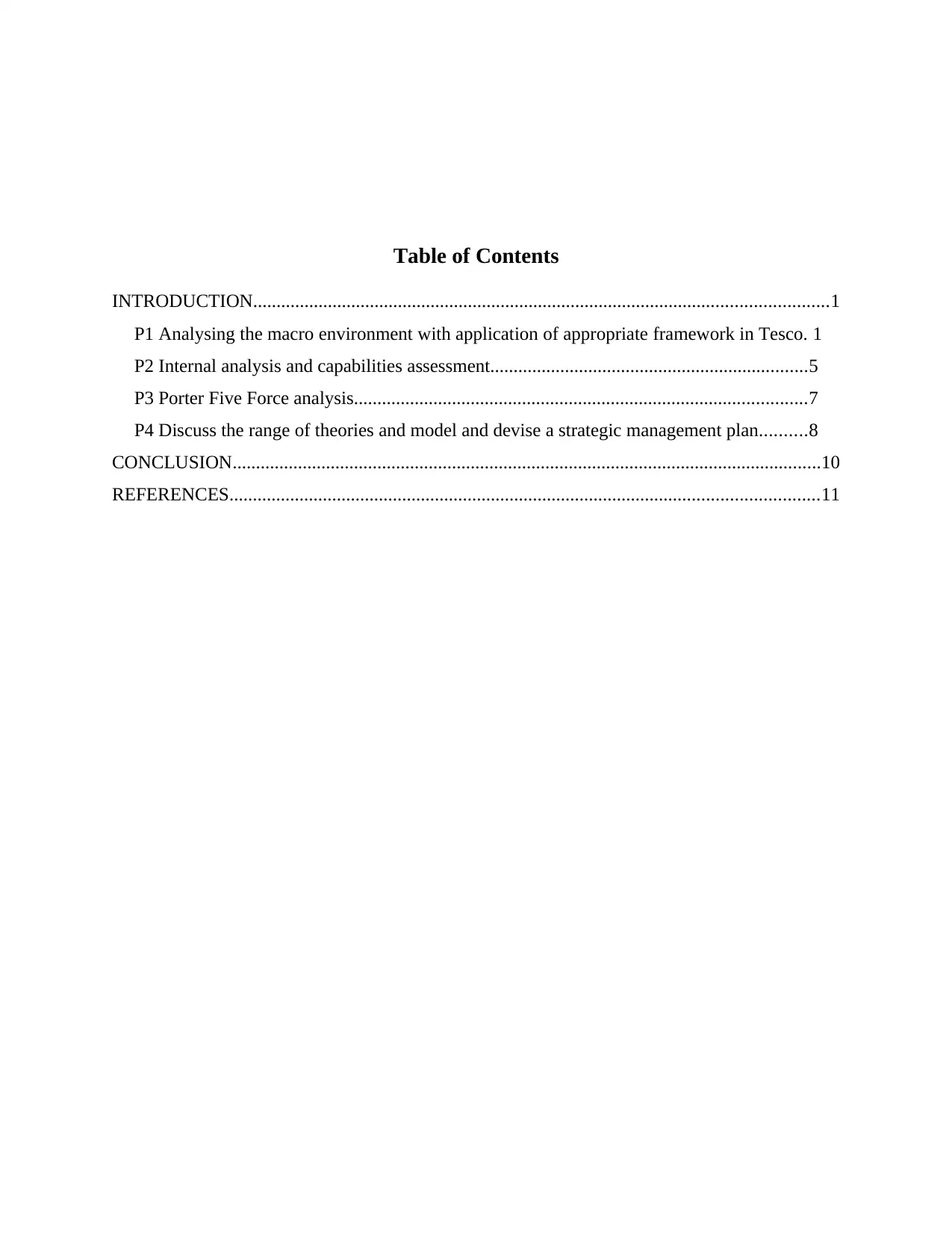
Table of Contents
INTRODUCTION...........................................................................................................................1
P1 Analysing the macro environment with application of appropriate framework in Tesco. 1
P2 Internal analysis and capabilities assessment....................................................................5
P3 Porter Five Force analysis.................................................................................................7
P4 Discuss the range of theories and model and devise a strategic management plan..........8
CONCLUSION..............................................................................................................................10
REFERENCES..............................................................................................................................11
INTRODUCTION...........................................................................................................................1
P1 Analysing the macro environment with application of appropriate framework in Tesco. 1
P2 Internal analysis and capabilities assessment....................................................................5
P3 Porter Five Force analysis.................................................................................................7
P4 Discuss the range of theories and model and devise a strategic management plan..........8
CONCLUSION..............................................................................................................................10
REFERENCES..............................................................................................................................11
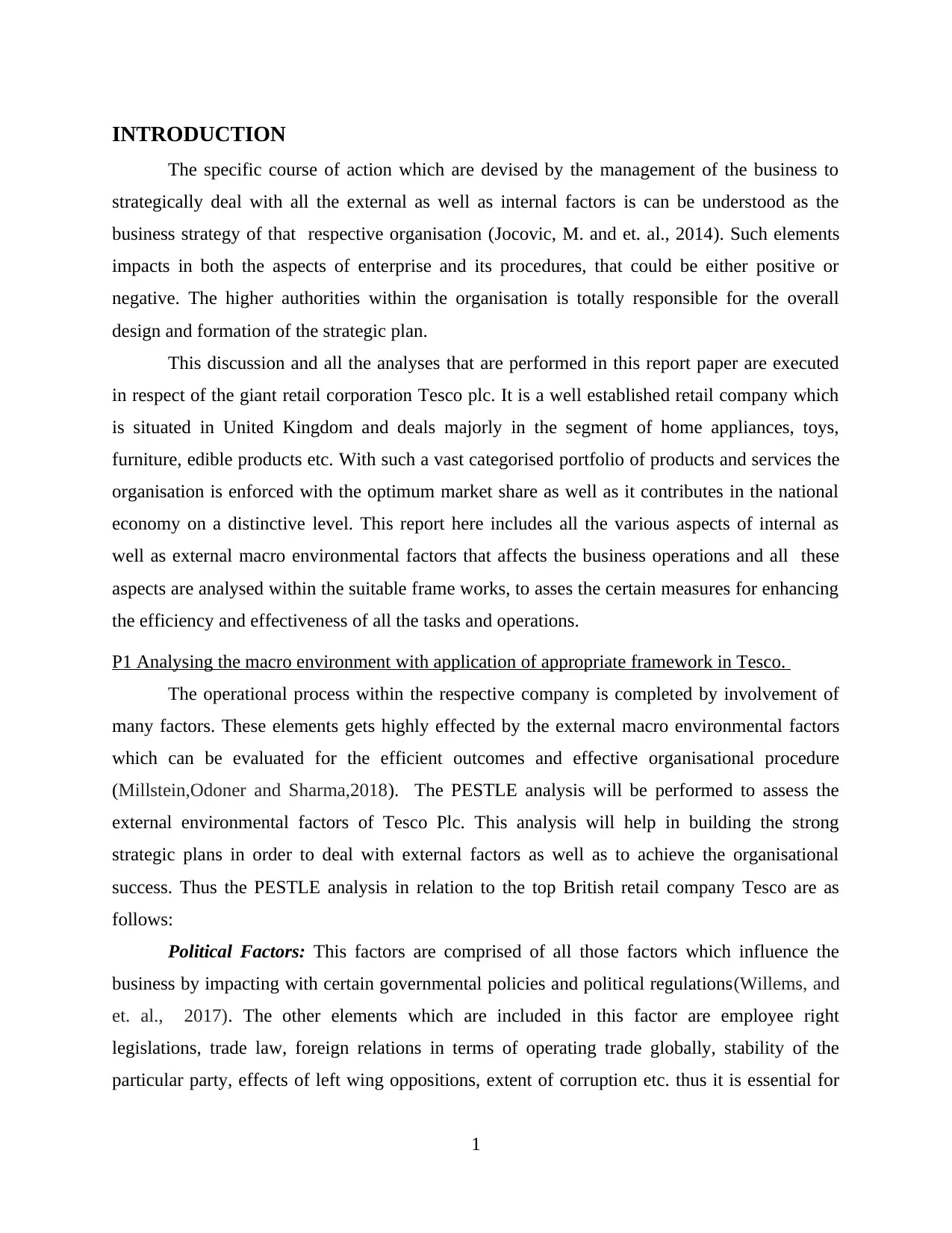
INTRODUCTION
The specific course of action which are devised by the management of the business to
strategically deal with all the external as well as internal factors is can be understood as the
business strategy of that respective organisation (Jocovic, M. and et. al., 2014). Such elements
impacts in both the aspects of enterprise and its procedures, that could be either positive or
negative. The higher authorities within the organisation is totally responsible for the overall
design and formation of the strategic plan.
This discussion and all the analyses that are performed in this report paper are executed
in respect of the giant retail corporation Tesco plc. It is a well established retail company which
is situated in United Kingdom and deals majorly in the segment of home appliances, toys,
furniture, edible products etc. With such a vast categorised portfolio of products and services the
organisation is enforced with the optimum market share as well as it contributes in the national
economy on a distinctive level. This report here includes all the various aspects of internal as
well as external macro environmental factors that affects the business operations and all these
aspects are analysed within the suitable frame works, to asses the certain measures for enhancing
the efficiency and effectiveness of all the tasks and operations.
P1 Analysing the macro environment with application of appropriate framework in Tesco.
The operational process within the respective company is completed by involvement of
many factors. These elements gets highly effected by the external macro environmental factors
which can be evaluated for the efficient outcomes and effective organisational procedure
(Millstein,Odoner and Sharma,2018). The PESTLE analysis will be performed to assess the
external environmental factors of Tesco Plc. This analysis will help in building the strong
strategic plans in order to deal with external factors as well as to achieve the organisational
success. Thus the PESTLE analysis in relation to the top British retail company Tesco are as
follows:
Political Factors: This factors are comprised of all those factors which influence the
business by impacting with certain governmental policies and political regulations(Willems, and
et. al., 2017). The other elements which are included in this factor are employee right
legislations, trade law, foreign relations in terms of operating trade globally, stability of the
particular party, effects of left wing oppositions, extent of corruption etc. thus it is essential for
1
The specific course of action which are devised by the management of the business to
strategically deal with all the external as well as internal factors is can be understood as the
business strategy of that respective organisation (Jocovic, M. and et. al., 2014). Such elements
impacts in both the aspects of enterprise and its procedures, that could be either positive or
negative. The higher authorities within the organisation is totally responsible for the overall
design and formation of the strategic plan.
This discussion and all the analyses that are performed in this report paper are executed
in respect of the giant retail corporation Tesco plc. It is a well established retail company which
is situated in United Kingdom and deals majorly in the segment of home appliances, toys,
furniture, edible products etc. With such a vast categorised portfolio of products and services the
organisation is enforced with the optimum market share as well as it contributes in the national
economy on a distinctive level. This report here includes all the various aspects of internal as
well as external macro environmental factors that affects the business operations and all these
aspects are analysed within the suitable frame works, to asses the certain measures for enhancing
the efficiency and effectiveness of all the tasks and operations.
P1 Analysing the macro environment with application of appropriate framework in Tesco.
The operational process within the respective company is completed by involvement of
many factors. These elements gets highly effected by the external macro environmental factors
which can be evaluated for the efficient outcomes and effective organisational procedure
(Millstein,Odoner and Sharma,2018). The PESTLE analysis will be performed to assess the
external environmental factors of Tesco Plc. This analysis will help in building the strong
strategic plans in order to deal with external factors as well as to achieve the organisational
success. Thus the PESTLE analysis in relation to the top British retail company Tesco are as
follows:
Political Factors: This factors are comprised of all those factors which influence the
business by impacting with certain governmental policies and political regulations(Willems, and
et. al., 2017). The other elements which are included in this factor are employee right
legislations, trade law, foreign relations in terms of operating trade globally, stability of the
particular party, effects of left wing oppositions, extent of corruption etc. thus it is essential for
1
⊘ This is a preview!⊘
Do you want full access?
Subscribe today to unlock all pages.

Trusted by 1+ million students worldwide
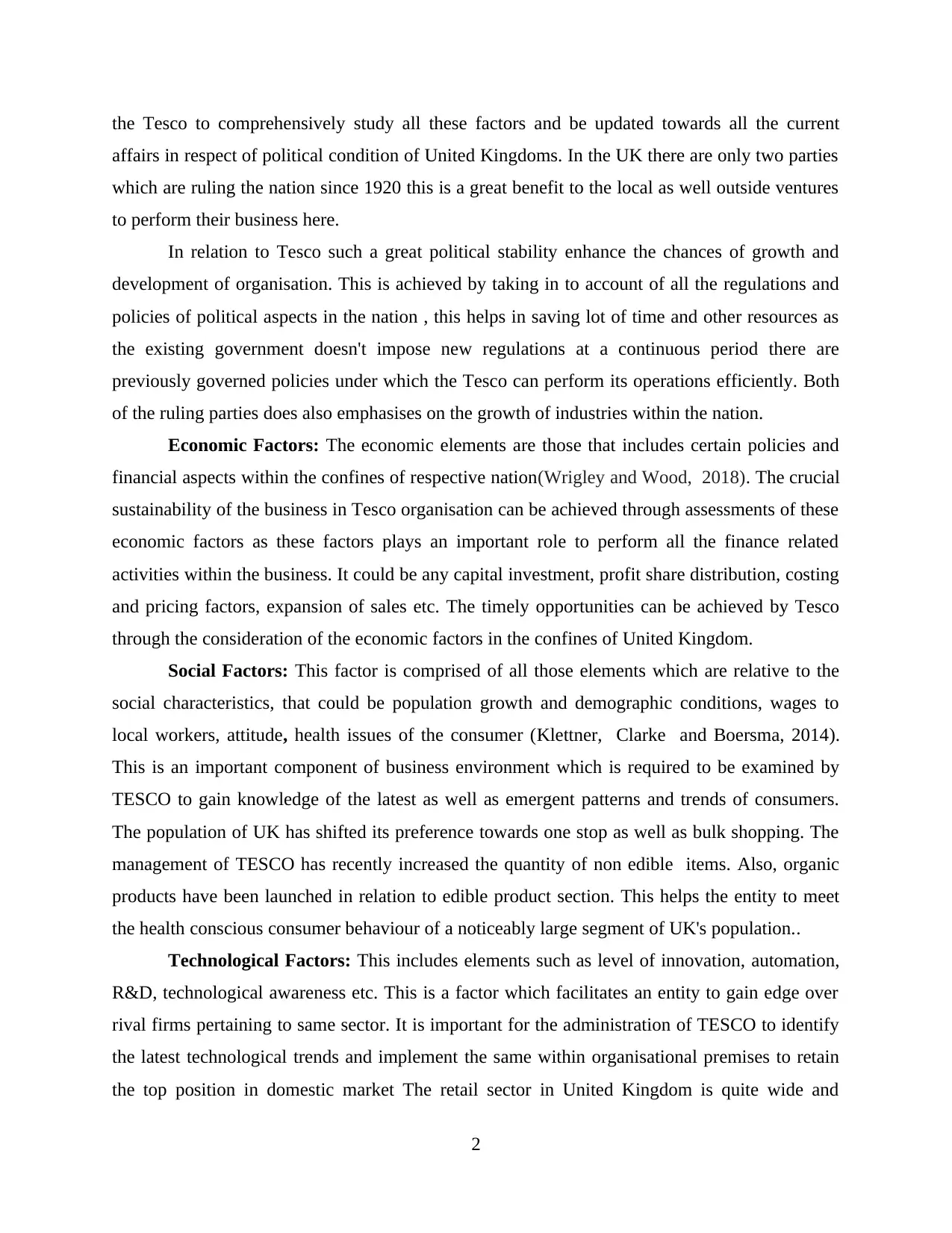
the Tesco to comprehensively study all these factors and be updated towards all the current
affairs in respect of political condition of United Kingdoms. In the UK there are only two parties
which are ruling the nation since 1920 this is a great benefit to the local as well outside ventures
to perform their business here.
In relation to Tesco such a great political stability enhance the chances of growth and
development of organisation. This is achieved by taking in to account of all the regulations and
policies of political aspects in the nation , this helps in saving lot of time and other resources as
the existing government doesn't impose new regulations at a continuous period there are
previously governed policies under which the Tesco can perform its operations efficiently. Both
of the ruling parties does also emphasises on the growth of industries within the nation.
Economic Factors: The economic elements are those that includes certain policies and
financial aspects within the confines of respective nation(Wrigley and Wood, 2018). The crucial
sustainability of the business in Tesco organisation can be achieved through assessments of these
economic factors as these factors plays an important role to perform all the finance related
activities within the business. It could be any capital investment, profit share distribution, costing
and pricing factors, expansion of sales etc. The timely opportunities can be achieved by Tesco
through the consideration of the economic factors in the confines of United Kingdom.
Social Factors: This factor is comprised of all those elements which are relative to the
social characteristics, that could be population growth and demographic conditions, wages to
local workers, attitude, health issues of the consumer (Klettner, Clarke and Boersma, 2014).
This is an important component of business environment which is required to be examined by
TESCO to gain knowledge of the latest as well as emergent patterns and trends of consumers.
The population of UK has shifted its preference towards one stop as well as bulk shopping. The
management of TESCO has recently increased the quantity of non edible items. Also, organic
products have been launched in relation to edible product section. This helps the entity to meet
the health conscious consumer behaviour of a noticeably large segment of UK's population..
Technological Factors: This includes elements such as level of innovation, automation,
R&D, technological awareness etc. This is a factor which facilitates an entity to gain edge over
rival firms pertaining to same sector. It is important for the administration of TESCO to identify
the latest technological trends and implement the same within organisational premises to retain
the top position in domestic market The retail sector in United Kingdom is quite wide and
2
affairs in respect of political condition of United Kingdoms. In the UK there are only two parties
which are ruling the nation since 1920 this is a great benefit to the local as well outside ventures
to perform their business here.
In relation to Tesco such a great political stability enhance the chances of growth and
development of organisation. This is achieved by taking in to account of all the regulations and
policies of political aspects in the nation , this helps in saving lot of time and other resources as
the existing government doesn't impose new regulations at a continuous period there are
previously governed policies under which the Tesco can perform its operations efficiently. Both
of the ruling parties does also emphasises on the growth of industries within the nation.
Economic Factors: The economic elements are those that includes certain policies and
financial aspects within the confines of respective nation(Wrigley and Wood, 2018). The crucial
sustainability of the business in Tesco organisation can be achieved through assessments of these
economic factors as these factors plays an important role to perform all the finance related
activities within the business. It could be any capital investment, profit share distribution, costing
and pricing factors, expansion of sales etc. The timely opportunities can be achieved by Tesco
through the consideration of the economic factors in the confines of United Kingdom.
Social Factors: This factor is comprised of all those elements which are relative to the
social characteristics, that could be population growth and demographic conditions, wages to
local workers, attitude, health issues of the consumer (Klettner, Clarke and Boersma, 2014).
This is an important component of business environment which is required to be examined by
TESCO to gain knowledge of the latest as well as emergent patterns and trends of consumers.
The population of UK has shifted its preference towards one stop as well as bulk shopping. The
management of TESCO has recently increased the quantity of non edible items. Also, organic
products have been launched in relation to edible product section. This helps the entity to meet
the health conscious consumer behaviour of a noticeably large segment of UK's population..
Technological Factors: This includes elements such as level of innovation, automation,
R&D, technological awareness etc. This is a factor which facilitates an entity to gain edge over
rival firms pertaining to same sector. It is important for the administration of TESCO to identify
the latest technological trends and implement the same within organisational premises to retain
the top position in domestic market The retail sector in United Kingdom is quite wide and
2
Paraphrase This Document
Need a fresh take? Get an instant paraphrase of this document with our AI Paraphraser
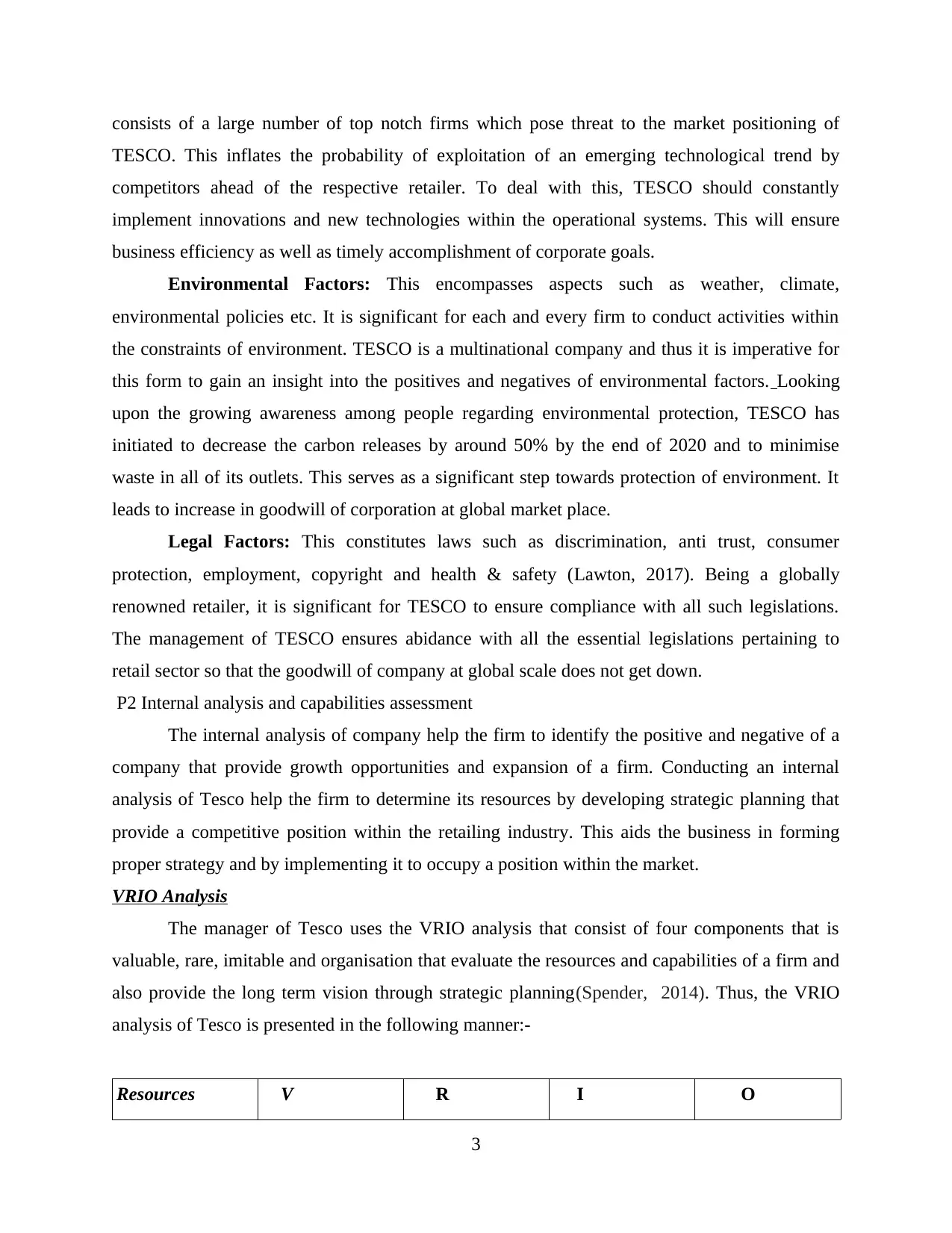
consists of a large number of top notch firms which pose threat to the market positioning of
TESCO. This inflates the probability of exploitation of an emerging technological trend by
competitors ahead of the respective retailer. To deal with this, TESCO should constantly
implement innovations and new technologies within the operational systems. This will ensure
business efficiency as well as timely accomplishment of corporate goals.
Environmental Factors: This encompasses aspects such as weather, climate,
environmental policies etc. It is significant for each and every firm to conduct activities within
the constraints of environment. TESCO is a multinational company and thus it is imperative for
this form to gain an insight into the positives and negatives of environmental factors. Looking
upon the growing awareness among people regarding environmental protection, TESCO has
initiated to decrease the carbon releases by around 50% by the end of 2020 and to minimise
waste in all of its outlets. This serves as a significant step towards protection of environment. It
leads to increase in goodwill of corporation at global market place.
Legal Factors: This constitutes laws such as discrimination, anti trust, consumer
protection, employment, copyright and health & safety (Lawton, 2017). Being a globally
renowned retailer, it is significant for TESCO to ensure compliance with all such legislations.
The management of TESCO ensures abidance with all the essential legislations pertaining to
retail sector so that the goodwill of company at global scale does not get down.
P2 Internal analysis and capabilities assessment
The internal analysis of company help the firm to identify the positive and negative of a
company that provide growth opportunities and expansion of a firm. Conducting an internal
analysis of Tesco help the firm to determine its resources by developing strategic planning that
provide a competitive position within the retailing industry. This aids the business in forming
proper strategy and by implementing it to occupy a position within the market.
VRIO Analysis
The manager of Tesco uses the VRIO analysis that consist of four components that is
valuable, rare, imitable and organisation that evaluate the resources and capabilities of a firm and
also provide the long term vision through strategic planning(Spender, 2014). Thus, the VRIO
analysis of Tesco is presented in the following manner:-
Resources V R I O
3
TESCO. This inflates the probability of exploitation of an emerging technological trend by
competitors ahead of the respective retailer. To deal with this, TESCO should constantly
implement innovations and new technologies within the operational systems. This will ensure
business efficiency as well as timely accomplishment of corporate goals.
Environmental Factors: This encompasses aspects such as weather, climate,
environmental policies etc. It is significant for each and every firm to conduct activities within
the constraints of environment. TESCO is a multinational company and thus it is imperative for
this form to gain an insight into the positives and negatives of environmental factors. Looking
upon the growing awareness among people regarding environmental protection, TESCO has
initiated to decrease the carbon releases by around 50% by the end of 2020 and to minimise
waste in all of its outlets. This serves as a significant step towards protection of environment. It
leads to increase in goodwill of corporation at global market place.
Legal Factors: This constitutes laws such as discrimination, anti trust, consumer
protection, employment, copyright and health & safety (Lawton, 2017). Being a globally
renowned retailer, it is significant for TESCO to ensure compliance with all such legislations.
The management of TESCO ensures abidance with all the essential legislations pertaining to
retail sector so that the goodwill of company at global scale does not get down.
P2 Internal analysis and capabilities assessment
The internal analysis of company help the firm to identify the positive and negative of a
company that provide growth opportunities and expansion of a firm. Conducting an internal
analysis of Tesco help the firm to determine its resources by developing strategic planning that
provide a competitive position within the retailing industry. This aids the business in forming
proper strategy and by implementing it to occupy a position within the market.
VRIO Analysis
The manager of Tesco uses the VRIO analysis that consist of four components that is
valuable, rare, imitable and organisation that evaluate the resources and capabilities of a firm and
also provide the long term vision through strategic planning(Spender, 2014). Thus, the VRIO
analysis of Tesco is presented in the following manner:-
Resources V R I O
3
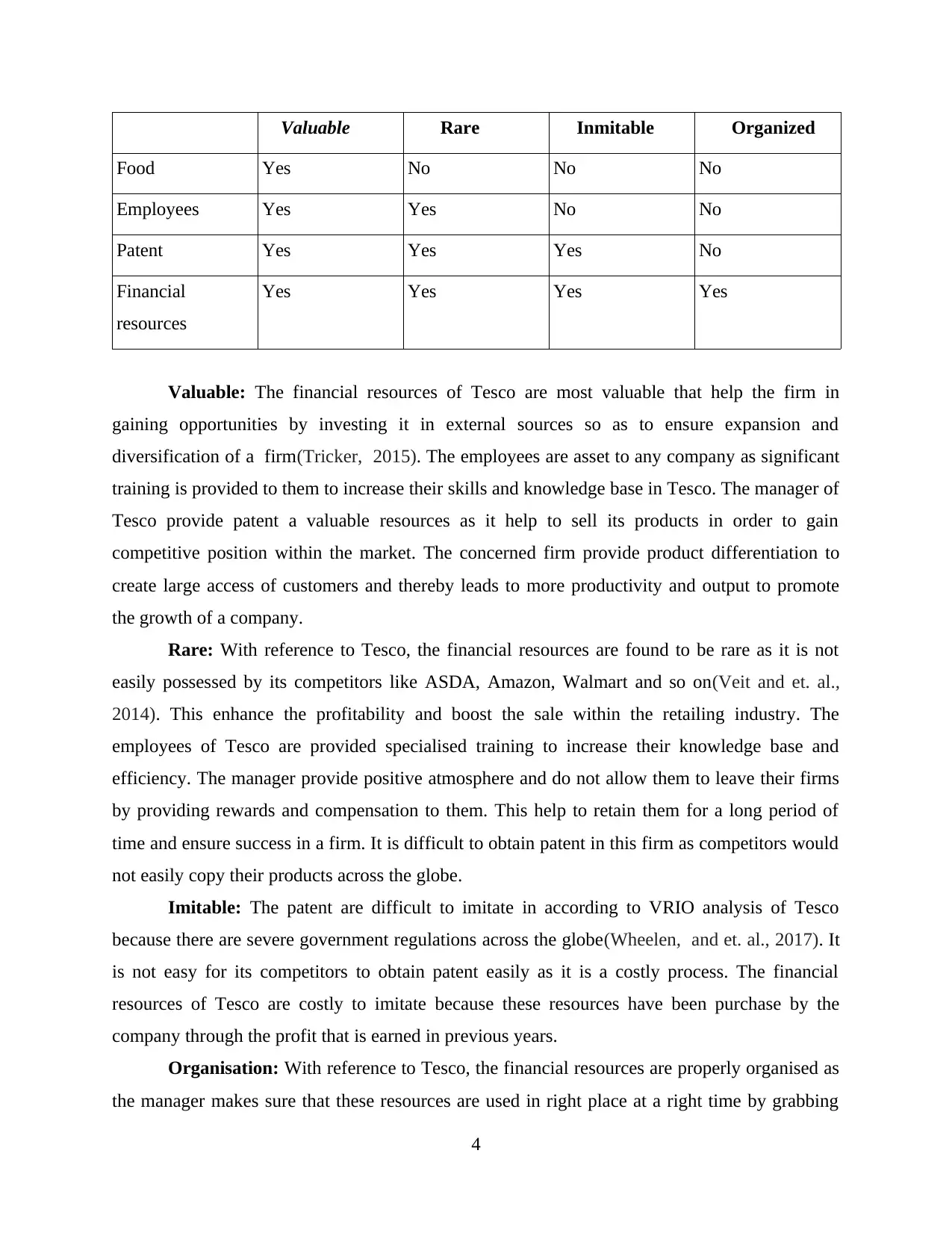
Valuable Rare Inmitable Organized
Food Yes No No No
Employees Yes Yes No No
Patent Yes Yes Yes No
Financial
resources
Yes Yes Yes Yes
Valuable: The financial resources of Tesco are most valuable that help the firm in
gaining opportunities by investing it in external sources so as to ensure expansion and
diversification of a firm(Tricker, 2015). The employees are asset to any company as significant
training is provided to them to increase their skills and knowledge base in Tesco. The manager of
Tesco provide patent a valuable resources as it help to sell its products in order to gain
competitive position within the market. The concerned firm provide product differentiation to
create large access of customers and thereby leads to more productivity and output to promote
the growth of a company.
Rare: With reference to Tesco, the financial resources are found to be rare as it is not
easily possessed by its competitors like ASDA, Amazon, Walmart and so on(Veit and et. al.,
2014). This enhance the profitability and boost the sale within the retailing industry. The
employees of Tesco are provided specialised training to increase their knowledge base and
efficiency. The manager provide positive atmosphere and do not allow them to leave their firms
by providing rewards and compensation to them. This help to retain them for a long period of
time and ensure success in a firm. It is difficult to obtain patent in this firm as competitors would
not easily copy their products across the globe.
Imitable: The patent are difficult to imitate in according to VRIO analysis of Tesco
because there are severe government regulations across the globe(Wheelen, and et. al., 2017). It
is not easy for its competitors to obtain patent easily as it is a costly process. The financial
resources of Tesco are costly to imitate because these resources have been purchase by the
company through the profit that is earned in previous years.
Organisation: With reference to Tesco, the financial resources are properly organised as
the manager makes sure that these resources are used in right place at a right time by grabbing
4
Food Yes No No No
Employees Yes Yes No No
Patent Yes Yes Yes No
Financial
resources
Yes Yes Yes Yes
Valuable: The financial resources of Tesco are most valuable that help the firm in
gaining opportunities by investing it in external sources so as to ensure expansion and
diversification of a firm(Tricker, 2015). The employees are asset to any company as significant
training is provided to them to increase their skills and knowledge base in Tesco. The manager of
Tesco provide patent a valuable resources as it help to sell its products in order to gain
competitive position within the market. The concerned firm provide product differentiation to
create large access of customers and thereby leads to more productivity and output to promote
the growth of a company.
Rare: With reference to Tesco, the financial resources are found to be rare as it is not
easily possessed by its competitors like ASDA, Amazon, Walmart and so on(Veit and et. al.,
2014). This enhance the profitability and boost the sale within the retailing industry. The
employees of Tesco are provided specialised training to increase their knowledge base and
efficiency. The manager provide positive atmosphere and do not allow them to leave their firms
by providing rewards and compensation to them. This help to retain them for a long period of
time and ensure success in a firm. It is difficult to obtain patent in this firm as competitors would
not easily copy their products across the globe.
Imitable: The patent are difficult to imitate in according to VRIO analysis of Tesco
because there are severe government regulations across the globe(Wheelen, and et. al., 2017). It
is not easy for its competitors to obtain patent easily as it is a costly process. The financial
resources of Tesco are costly to imitate because these resources have been purchase by the
company through the profit that is earned in previous years.
Organisation: With reference to Tesco, the financial resources are properly organised as
the manager makes sure that these resources are used in right place at a right time by grabbing
4
⊘ This is a preview!⊘
Do you want full access?
Subscribe today to unlock all pages.

Trusted by 1+ million students worldwide
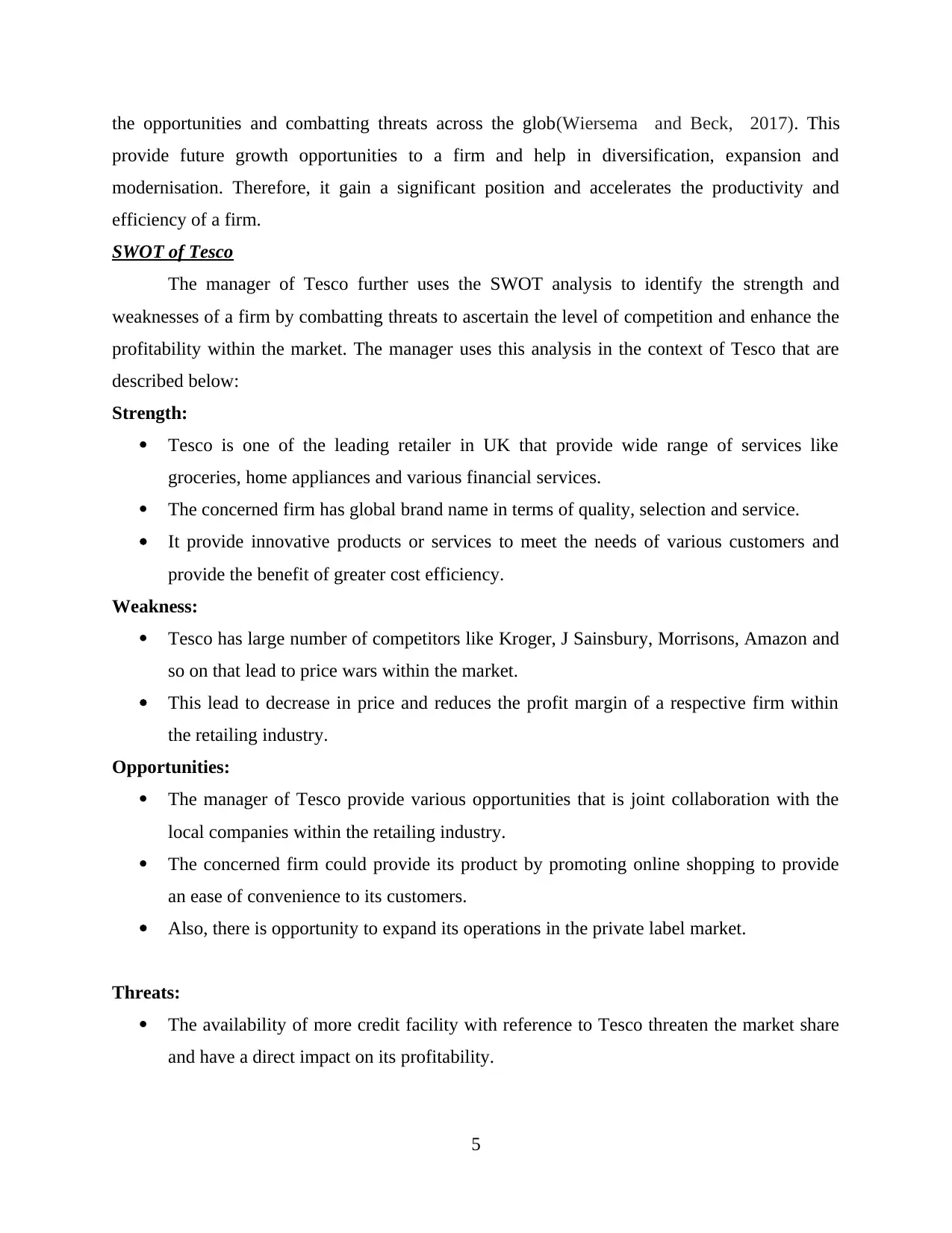
the opportunities and combatting threats across the glob(Wiersema and Beck, 2017). This
provide future growth opportunities to a firm and help in diversification, expansion and
modernisation. Therefore, it gain a significant position and accelerates the productivity and
efficiency of a firm.
SWOT of Tesco
The manager of Tesco further uses the SWOT analysis to identify the strength and
weaknesses of a firm by combatting threats to ascertain the level of competition and enhance the
profitability within the market. The manager uses this analysis in the context of Tesco that are
described below:
Strength:
Tesco is one of the leading retailer in UK that provide wide range of services like
groceries, home appliances and various financial services.
The concerned firm has global brand name in terms of quality, selection and service.
It provide innovative products or services to meet the needs of various customers and
provide the benefit of greater cost efficiency.
Weakness:
Tesco has large number of competitors like Kroger, J Sainsbury, Morrisons, Amazon and
so on that lead to price wars within the market.
This lead to decrease in price and reduces the profit margin of a respective firm within
the retailing industry.
Opportunities:
The manager of Tesco provide various opportunities that is joint collaboration with the
local companies within the retailing industry.
The concerned firm could provide its product by promoting online shopping to provide
an ease of convenience to its customers.
Also, there is opportunity to expand its operations in the private label market.
Threats:
The availability of more credit facility with reference to Tesco threaten the market share
and have a direct impact on its profitability.
5
provide future growth opportunities to a firm and help in diversification, expansion and
modernisation. Therefore, it gain a significant position and accelerates the productivity and
efficiency of a firm.
SWOT of Tesco
The manager of Tesco further uses the SWOT analysis to identify the strength and
weaknesses of a firm by combatting threats to ascertain the level of competition and enhance the
profitability within the market. The manager uses this analysis in the context of Tesco that are
described below:
Strength:
Tesco is one of the leading retailer in UK that provide wide range of services like
groceries, home appliances and various financial services.
The concerned firm has global brand name in terms of quality, selection and service.
It provide innovative products or services to meet the needs of various customers and
provide the benefit of greater cost efficiency.
Weakness:
Tesco has large number of competitors like Kroger, J Sainsbury, Morrisons, Amazon and
so on that lead to price wars within the market.
This lead to decrease in price and reduces the profit margin of a respective firm within
the retailing industry.
Opportunities:
The manager of Tesco provide various opportunities that is joint collaboration with the
local companies within the retailing industry.
The concerned firm could provide its product by promoting online shopping to provide
an ease of convenience to its customers.
Also, there is opportunity to expand its operations in the private label market.
Threats:
The availability of more credit facility with reference to Tesco threaten the market share
and have a direct impact on its profitability.
5
Paraphrase This Document
Need a fresh take? Get an instant paraphrase of this document with our AI Paraphraser
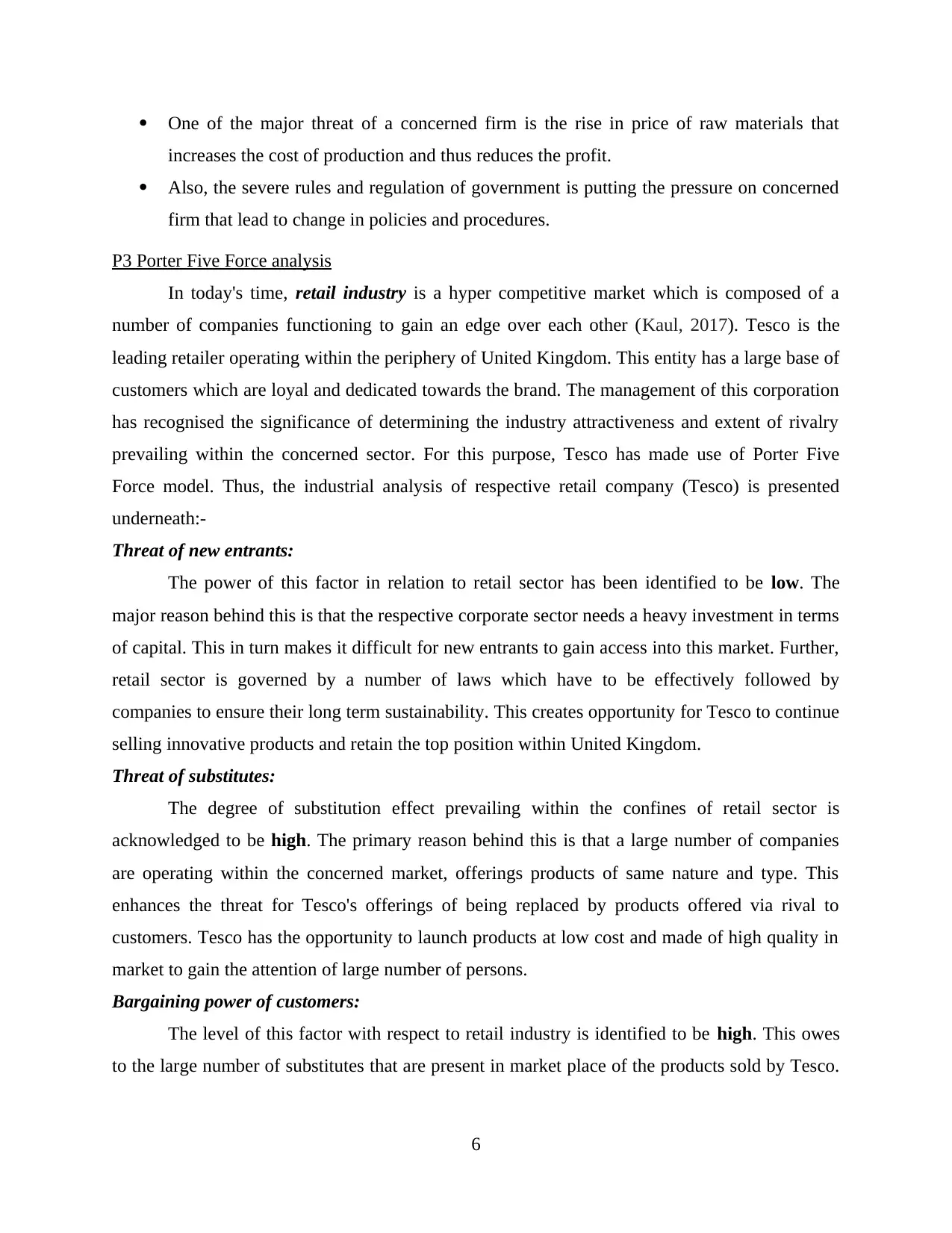
One of the major threat of a concerned firm is the rise in price of raw materials that
increases the cost of production and thus reduces the profit.
Also, the severe rules and regulation of government is putting the pressure on concerned
firm that lead to change in policies and procedures.
P3 Porter Five Force analysis
In today's time, retail industry is a hyper competitive market which is composed of a
number of companies functioning to gain an edge over each other (Kaul, 2017). Tesco is the
leading retailer operating within the periphery of United Kingdom. This entity has a large base of
customers which are loyal and dedicated towards the brand. The management of this corporation
has recognised the significance of determining the industry attractiveness and extent of rivalry
prevailing within the concerned sector. For this purpose, Tesco has made use of Porter Five
Force model. Thus, the industrial analysis of respective retail company (Tesco) is presented
underneath:-
Threat of new entrants:
The power of this factor in relation to retail sector has been identified to be low. The
major reason behind this is that the respective corporate sector needs a heavy investment in terms
of capital. This in turn makes it difficult for new entrants to gain access into this market. Further,
retail sector is governed by a number of laws which have to be effectively followed by
companies to ensure their long term sustainability. This creates opportunity for Tesco to continue
selling innovative products and retain the top position within United Kingdom.
Threat of substitutes:
The degree of substitution effect prevailing within the confines of retail sector is
acknowledged to be high. The primary reason behind this is that a large number of companies
are operating within the concerned market, offerings products of same nature and type. This
enhances the threat for Tesco's offerings of being replaced by products offered via rival to
customers. Tesco has the opportunity to launch products at low cost and made of high quality in
market to gain the attention of large number of persons.
Bargaining power of customers:
The level of this factor with respect to retail industry is identified to be high. This owes
to the large number of substitutes that are present in market place of the products sold by Tesco.
6
increases the cost of production and thus reduces the profit.
Also, the severe rules and regulation of government is putting the pressure on concerned
firm that lead to change in policies and procedures.
P3 Porter Five Force analysis
In today's time, retail industry is a hyper competitive market which is composed of a
number of companies functioning to gain an edge over each other (Kaul, 2017). Tesco is the
leading retailer operating within the periphery of United Kingdom. This entity has a large base of
customers which are loyal and dedicated towards the brand. The management of this corporation
has recognised the significance of determining the industry attractiveness and extent of rivalry
prevailing within the concerned sector. For this purpose, Tesco has made use of Porter Five
Force model. Thus, the industrial analysis of respective retail company (Tesco) is presented
underneath:-
Threat of new entrants:
The power of this factor in relation to retail sector has been identified to be low. The
major reason behind this is that the respective corporate sector needs a heavy investment in terms
of capital. This in turn makes it difficult for new entrants to gain access into this market. Further,
retail sector is governed by a number of laws which have to be effectively followed by
companies to ensure their long term sustainability. This creates opportunity for Tesco to continue
selling innovative products and retain the top position within United Kingdom.
Threat of substitutes:
The degree of substitution effect prevailing within the confines of retail sector is
acknowledged to be high. The primary reason behind this is that a large number of companies
are operating within the concerned market, offerings products of same nature and type. This
enhances the threat for Tesco's offerings of being replaced by products offered via rival to
customers. Tesco has the opportunity to launch products at low cost and made of high quality in
market to gain the attention of large number of persons.
Bargaining power of customers:
The level of this factor with respect to retail industry is identified to be high. This owes
to the large number of substitutes that are present in market place of the products sold by Tesco.
6
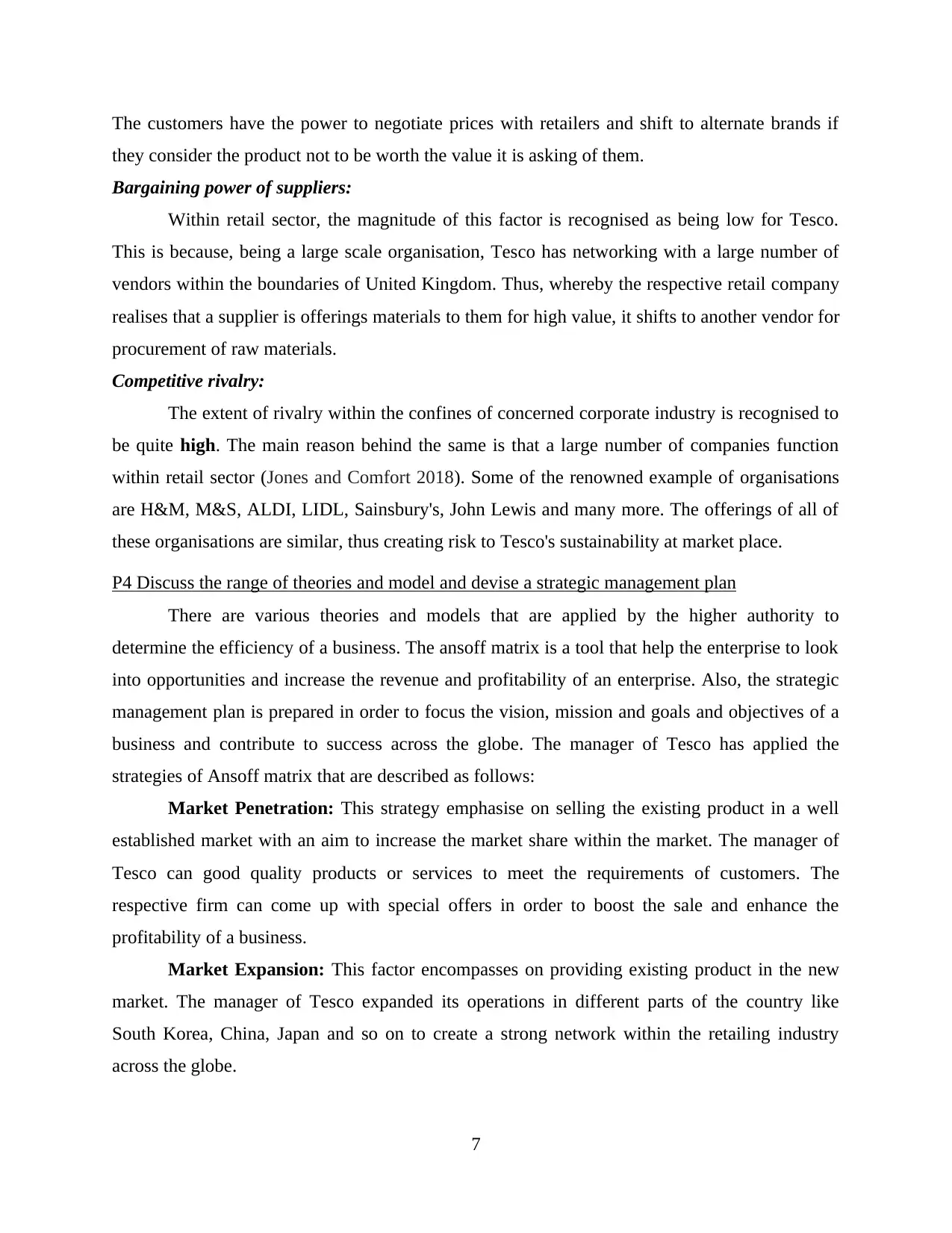
The customers have the power to negotiate prices with retailers and shift to alternate brands if
they consider the product not to be worth the value it is asking of them.
Bargaining power of suppliers:
Within retail sector, the magnitude of this factor is recognised as being low for Tesco.
This is because, being a large scale organisation, Tesco has networking with a large number of
vendors within the boundaries of United Kingdom. Thus, whereby the respective retail company
realises that a supplier is offerings materials to them for high value, it shifts to another vendor for
procurement of raw materials.
Competitive rivalry:
The extent of rivalry within the confines of concerned corporate industry is recognised to
be quite high. The main reason behind the same is that a large number of companies function
within retail sector (Jones and Comfort 2018). Some of the renowned example of organisations
are H&M, M&S, ALDI, LIDL, Sainsbury's, John Lewis and many more. The offerings of all of
these organisations are similar, thus creating risk to Tesco's sustainability at market place.
P4 Discuss the range of theories and model and devise a strategic management plan
There are various theories and models that are applied by the higher authority to
determine the efficiency of a business. The ansoff matrix is a tool that help the enterprise to look
into opportunities and increase the revenue and profitability of an enterprise. Also, the strategic
management plan is prepared in order to focus the vision, mission and goals and objectives of a
business and contribute to success across the globe. The manager of Tesco has applied the
strategies of Ansoff matrix that are described as follows:
Market Penetration: This strategy emphasise on selling the existing product in a well
established market with an aim to increase the market share within the market. The manager of
Tesco can good quality products or services to meet the requirements of customers. The
respective firm can come up with special offers in order to boost the sale and enhance the
profitability of a business.
Market Expansion: This factor encompasses on providing existing product in the new
market. The manager of Tesco expanded its operations in different parts of the country like
South Korea, China, Japan and so on to create a strong network within the retailing industry
across the globe.
7
they consider the product not to be worth the value it is asking of them.
Bargaining power of suppliers:
Within retail sector, the magnitude of this factor is recognised as being low for Tesco.
This is because, being a large scale organisation, Tesco has networking with a large number of
vendors within the boundaries of United Kingdom. Thus, whereby the respective retail company
realises that a supplier is offerings materials to them for high value, it shifts to another vendor for
procurement of raw materials.
Competitive rivalry:
The extent of rivalry within the confines of concerned corporate industry is recognised to
be quite high. The main reason behind the same is that a large number of companies function
within retail sector (Jones and Comfort 2018). Some of the renowned example of organisations
are H&M, M&S, ALDI, LIDL, Sainsbury's, John Lewis and many more. The offerings of all of
these organisations are similar, thus creating risk to Tesco's sustainability at market place.
P4 Discuss the range of theories and model and devise a strategic management plan
There are various theories and models that are applied by the higher authority to
determine the efficiency of a business. The ansoff matrix is a tool that help the enterprise to look
into opportunities and increase the revenue and profitability of an enterprise. Also, the strategic
management plan is prepared in order to focus the vision, mission and goals and objectives of a
business and contribute to success across the globe. The manager of Tesco has applied the
strategies of Ansoff matrix that are described as follows:
Market Penetration: This strategy emphasise on selling the existing product in a well
established market with an aim to increase the market share within the market. The manager of
Tesco can good quality products or services to meet the requirements of customers. The
respective firm can come up with special offers in order to boost the sale and enhance the
profitability of a business.
Market Expansion: This factor encompasses on providing existing product in the new
market. The manager of Tesco expanded its operations in different parts of the country like
South Korea, China, Japan and so on to create a strong network within the retailing industry
across the globe.
7
⊘ This is a preview!⊘
Do you want full access?
Subscribe today to unlock all pages.

Trusted by 1+ million students worldwide
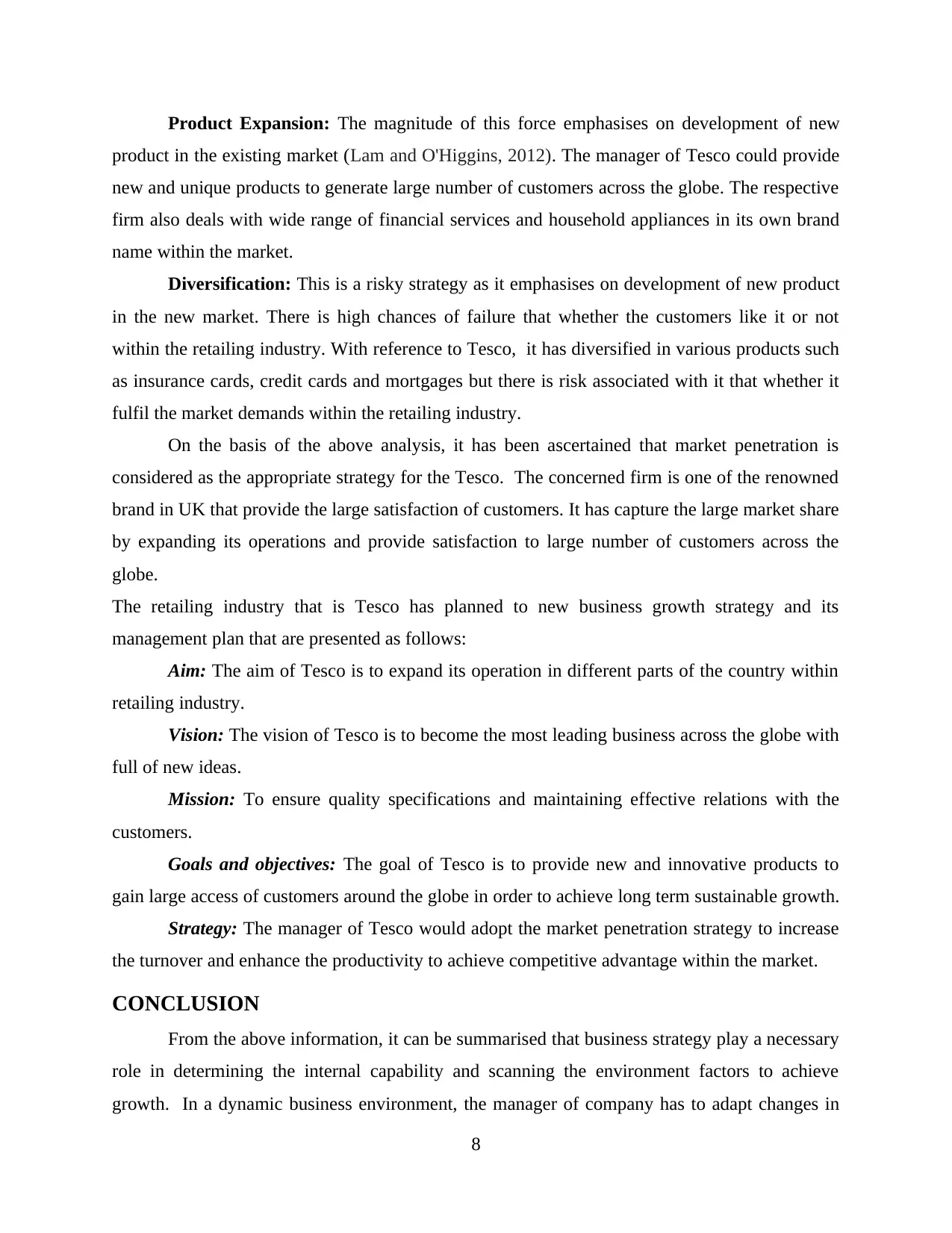
Product Expansion: The magnitude of this force emphasises on development of new
product in the existing market (Lam and O'Higgins, 2012). The manager of Tesco could provide
new and unique products to generate large number of customers across the globe. The respective
firm also deals with wide range of financial services and household appliances in its own brand
name within the market.
Diversification: This is a risky strategy as it emphasises on development of new product
in the new market. There is high chances of failure that whether the customers like it or not
within the retailing industry. With reference to Tesco, it has diversified in various products such
as insurance cards, credit cards and mortgages but there is risk associated with it that whether it
fulfil the market demands within the retailing industry.
On the basis of the above analysis, it has been ascertained that market penetration is
considered as the appropriate strategy for the Tesco. The concerned firm is one of the renowned
brand in UK that provide the large satisfaction of customers. It has capture the large market share
by expanding its operations and provide satisfaction to large number of customers across the
globe.
The retailing industry that is Tesco has planned to new business growth strategy and its
management plan that are presented as follows:
Aim: The aim of Tesco is to expand its operation in different parts of the country within
retailing industry.
Vision: The vision of Tesco is to become the most leading business across the globe with
full of new ideas.
Mission: To ensure quality specifications and maintaining effective relations with the
customers.
Goals and objectives: The goal of Tesco is to provide new and innovative products to
gain large access of customers around the globe in order to achieve long term sustainable growth.
Strategy: The manager of Tesco would adopt the market penetration strategy to increase
the turnover and enhance the productivity to achieve competitive advantage within the market.
CONCLUSION
From the above information, it can be summarised that business strategy play a necessary
role in determining the internal capability and scanning the environment factors to achieve
growth. In a dynamic business environment, the manager of company has to adapt changes in
8
product in the existing market (Lam and O'Higgins, 2012). The manager of Tesco could provide
new and unique products to generate large number of customers across the globe. The respective
firm also deals with wide range of financial services and household appliances in its own brand
name within the market.
Diversification: This is a risky strategy as it emphasises on development of new product
in the new market. There is high chances of failure that whether the customers like it or not
within the retailing industry. With reference to Tesco, it has diversified in various products such
as insurance cards, credit cards and mortgages but there is risk associated with it that whether it
fulfil the market demands within the retailing industry.
On the basis of the above analysis, it has been ascertained that market penetration is
considered as the appropriate strategy for the Tesco. The concerned firm is one of the renowned
brand in UK that provide the large satisfaction of customers. It has capture the large market share
by expanding its operations and provide satisfaction to large number of customers across the
globe.
The retailing industry that is Tesco has planned to new business growth strategy and its
management plan that are presented as follows:
Aim: The aim of Tesco is to expand its operation in different parts of the country within
retailing industry.
Vision: The vision of Tesco is to become the most leading business across the globe with
full of new ideas.
Mission: To ensure quality specifications and maintaining effective relations with the
customers.
Goals and objectives: The goal of Tesco is to provide new and innovative products to
gain large access of customers around the globe in order to achieve long term sustainable growth.
Strategy: The manager of Tesco would adopt the market penetration strategy to increase
the turnover and enhance the productivity to achieve competitive advantage within the market.
CONCLUSION
From the above information, it can be summarised that business strategy play a necessary
role in determining the internal capability and scanning the environment factors to achieve
growth. In a dynamic business environment, the manager of company has to adapt changes in
8
Paraphrase This Document
Need a fresh take? Get an instant paraphrase of this document with our AI Paraphraser
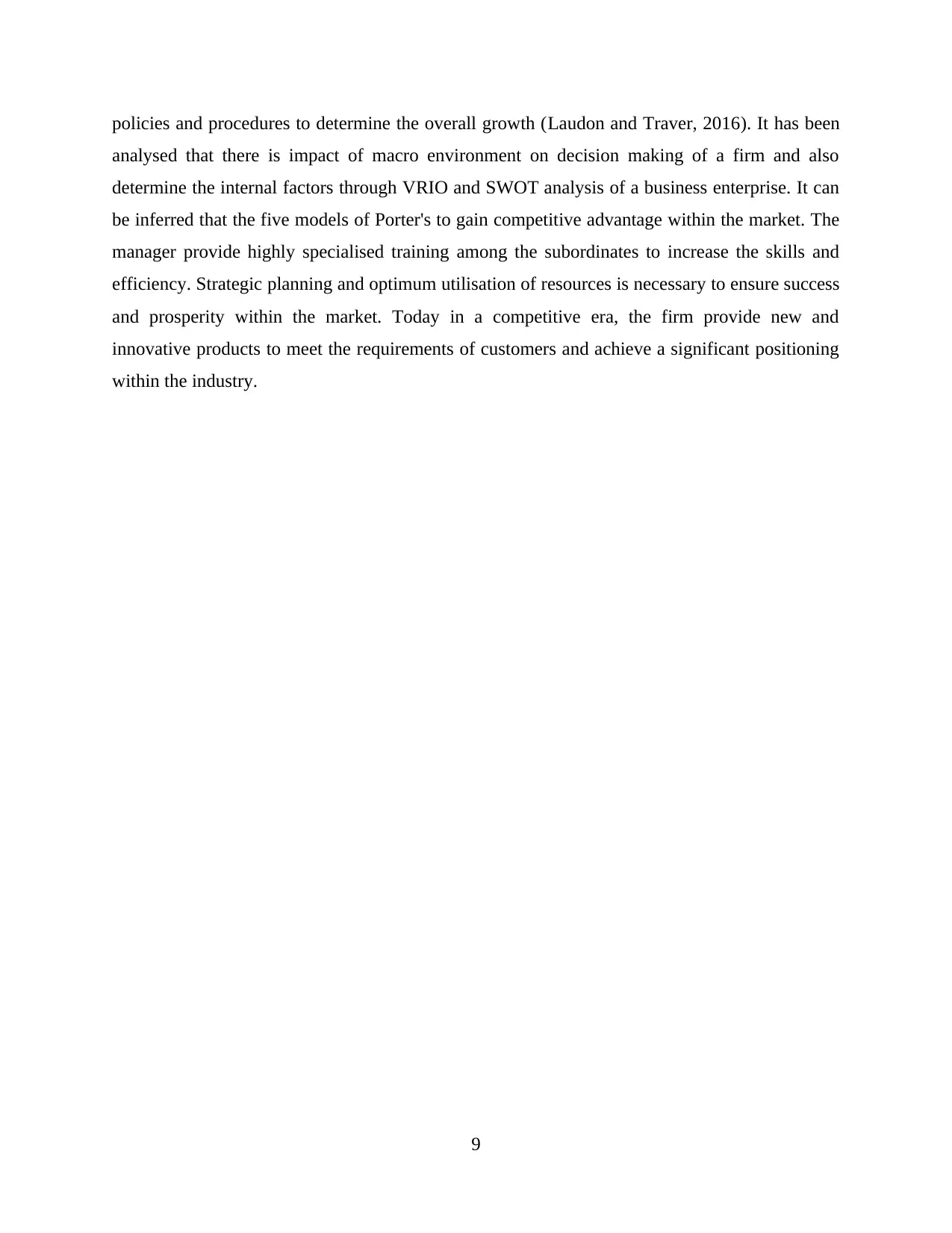
policies and procedures to determine the overall growth (Laudon and Traver, 2016). It has been
analysed that there is impact of macro environment on decision making of a firm and also
determine the internal factors through VRIO and SWOT analysis of a business enterprise. It can
be inferred that the five models of Porter's to gain competitive advantage within the market. The
manager provide highly specialised training among the subordinates to increase the skills and
efficiency. Strategic planning and optimum utilisation of resources is necessary to ensure success
and prosperity within the market. Today in a competitive era, the firm provide new and
innovative products to meet the requirements of customers and achieve a significant positioning
within the industry.
9
analysed that there is impact of macro environment on decision making of a firm and also
determine the internal factors through VRIO and SWOT analysis of a business enterprise. It can
be inferred that the five models of Porter's to gain competitive advantage within the market. The
manager provide highly specialised training among the subordinates to increase the skills and
efficiency. Strategic planning and optimum utilisation of resources is necessary to ensure success
and prosperity within the market. Today in a competitive era, the firm provide new and
innovative products to meet the requirements of customers and achieve a significant positioning
within the industry.
9
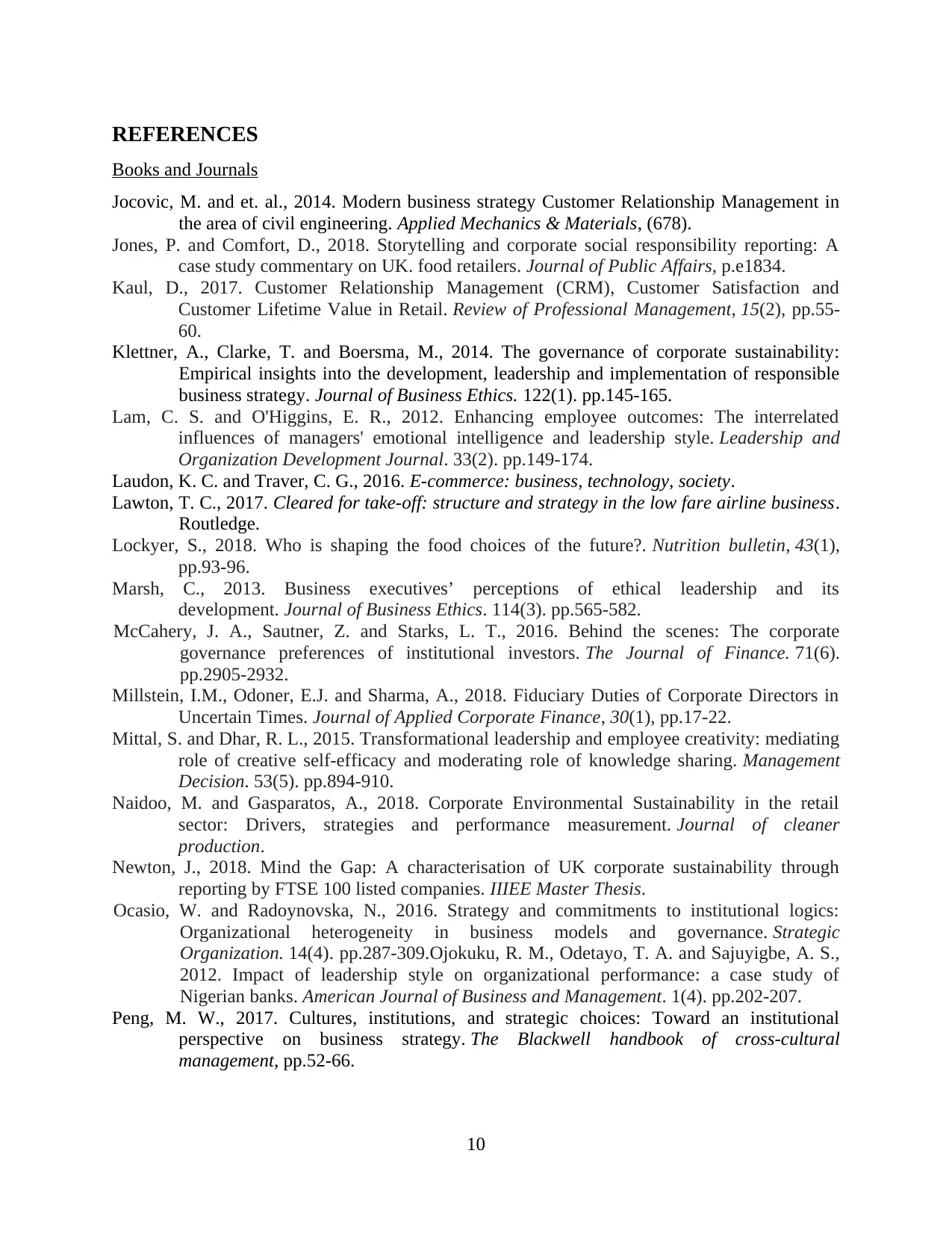
REFERENCES
Books and Journals
Jocovic, M. and et. al., 2014. Modern business strategy Customer Relationship Management in
the area of civil engineering. Applied Mechanics & Materials, (678).
Jones, P. and Comfort, D., 2018. Storytelling and corporate social responsibility reporting: A
case study commentary on UK. food retailers. Journal of Public Affairs, p.e1834.
Kaul, D., 2017. Customer Relationship Management (CRM), Customer Satisfaction and
Customer Lifetime Value in Retail. Review of Professional Management, 15(2), pp.55-
60.
Klettner, A., Clarke, T. and Boersma, M., 2014. The governance of corporate sustainability:
Empirical insights into the development, leadership and implementation of responsible
business strategy. Journal of Business Ethics. 122(1). pp.145-165.
Lam, C. S. and O'Higgins, E. R., 2012. Enhancing employee outcomes: The interrelated
influences of managers' emotional intelligence and leadership style. Leadership and
Organization Development Journal. 33(2). pp.149-174.
Laudon, K. C. and Traver, C. G., 2016. E-commerce: business, technology, society.
Lawton, T. C., 2017. Cleared for take-off: structure and strategy in the low fare airline business.
Routledge.
Lockyer, S., 2018. Who is shaping the food choices of the future?. Nutrition bulletin, 43(1),
pp.93-96.
Marsh, C., 2013. Business executives’ perceptions of ethical leadership and its
development. Journal of Business Ethics. 114(3). pp.565-582.
McCahery, J. A., Sautner, Z. and Starks, L. T., 2016. Behind the scenes: The corporate
governance preferences of institutional investors. The Journal of Finance. 71(6).
pp.2905-2932.
Millstein, I.M., Odoner, E.J. and Sharma, A., 2018. Fiduciary Duties of Corporate Directors in
Uncertain Times. Journal of Applied Corporate Finance, 30(1), pp.17-22.
Mittal, S. and Dhar, R. L., 2015. Transformational leadership and employee creativity: mediating
role of creative self-efficacy and moderating role of knowledge sharing. Management
Decision. 53(5). pp.894-910.
Naidoo, M. and Gasparatos, A., 2018. Corporate Environmental Sustainability in the retail
sector: Drivers, strategies and performance measurement. Journal of cleaner
production.
Newton, J., 2018. Mind the Gap: A characterisation of UK corporate sustainability through
reporting by FTSE 100 listed companies. IIIEE Master Thesis.
Ocasio, W. and Radoynovska, N., 2016. Strategy and commitments to institutional logics:
Organizational heterogeneity in business models and governance. Strategic
Organization. 14(4). pp.287-309.Ojokuku, R. M., Odetayo, T. A. and Sajuyigbe, A. S.,
2012. Impact of leadership style on organizational performance: a case study of
Nigerian banks. American Journal of Business and Management. 1(4). pp.202-207.
Peng, M. W., 2017. Cultures, institutions, and strategic choices: Toward an institutional
perspective on business strategy. The Blackwell handbook of cross‐cultural
management, pp.52-66.
10
Books and Journals
Jocovic, M. and et. al., 2014. Modern business strategy Customer Relationship Management in
the area of civil engineering. Applied Mechanics & Materials, (678).
Jones, P. and Comfort, D., 2018. Storytelling and corporate social responsibility reporting: A
case study commentary on UK. food retailers. Journal of Public Affairs, p.e1834.
Kaul, D., 2017. Customer Relationship Management (CRM), Customer Satisfaction and
Customer Lifetime Value in Retail. Review of Professional Management, 15(2), pp.55-
60.
Klettner, A., Clarke, T. and Boersma, M., 2014. The governance of corporate sustainability:
Empirical insights into the development, leadership and implementation of responsible
business strategy. Journal of Business Ethics. 122(1). pp.145-165.
Lam, C. S. and O'Higgins, E. R., 2012. Enhancing employee outcomes: The interrelated
influences of managers' emotional intelligence and leadership style. Leadership and
Organization Development Journal. 33(2). pp.149-174.
Laudon, K. C. and Traver, C. G., 2016. E-commerce: business, technology, society.
Lawton, T. C., 2017. Cleared for take-off: structure and strategy in the low fare airline business.
Routledge.
Lockyer, S., 2018. Who is shaping the food choices of the future?. Nutrition bulletin, 43(1),
pp.93-96.
Marsh, C., 2013. Business executives’ perceptions of ethical leadership and its
development. Journal of Business Ethics. 114(3). pp.565-582.
McCahery, J. A., Sautner, Z. and Starks, L. T., 2016. Behind the scenes: The corporate
governance preferences of institutional investors. The Journal of Finance. 71(6).
pp.2905-2932.
Millstein, I.M., Odoner, E.J. and Sharma, A., 2018. Fiduciary Duties of Corporate Directors in
Uncertain Times. Journal of Applied Corporate Finance, 30(1), pp.17-22.
Mittal, S. and Dhar, R. L., 2015. Transformational leadership and employee creativity: mediating
role of creative self-efficacy and moderating role of knowledge sharing. Management
Decision. 53(5). pp.894-910.
Naidoo, M. and Gasparatos, A., 2018. Corporate Environmental Sustainability in the retail
sector: Drivers, strategies and performance measurement. Journal of cleaner
production.
Newton, J., 2018. Mind the Gap: A characterisation of UK corporate sustainability through
reporting by FTSE 100 listed companies. IIIEE Master Thesis.
Ocasio, W. and Radoynovska, N., 2016. Strategy and commitments to institutional logics:
Organizational heterogeneity in business models and governance. Strategic
Organization. 14(4). pp.287-309.Ojokuku, R. M., Odetayo, T. A. and Sajuyigbe, A. S.,
2012. Impact of leadership style on organizational performance: a case study of
Nigerian banks. American Journal of Business and Management. 1(4). pp.202-207.
Peng, M. W., 2017. Cultures, institutions, and strategic choices: Toward an institutional
perspective on business strategy. The Blackwell handbook of cross‐cultural
management, pp.52-66.
10
⊘ This is a preview!⊘
Do you want full access?
Subscribe today to unlock all pages.

Trusted by 1+ million students worldwide
1 out of 13
Related Documents
Your All-in-One AI-Powered Toolkit for Academic Success.
+13062052269
info@desklib.com
Available 24*7 on WhatsApp / Email
![[object Object]](/_next/static/media/star-bottom.7253800d.svg)
Unlock your academic potential
Copyright © 2020–2025 A2Z Services. All Rights Reserved. Developed and managed by ZUCOL.




